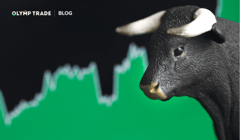This Expert Review covers the week from 16.05.2022 to 22.05.2022.

USD has firmed, reaching a 20-year high. Stock and cryptocurrency markets might continue going down. This week’s digest explains the factors behind the crypto market turmoil and suggests which currencies may be best to trade. Check it out!
Contents
Interact with the underlined words and green dots to get additional details and explanations.
Additional context for the visuals.
Explanations and definitions of terms.
Weekly Trends
NVIDIA ↓ -13.39%
Trading Down with $100 and a X20 multiplier on Forex Olymp Trade, you could have made $267,8.
AUD/JPY ↓ -3.99%
Trading Down with $100 and a X500 multiplier on Forex Olymp Trade, you could have made $1995.
EUR/AUD ↑ 1.35%
Trading up with $100 and a X500 multiplier on Forex Olymp Trade, you could have easily made $675.
Currency Markets
Recent US CPI Data Impressed Financial Markets
While rising prices are a major global concern, aggressive rate hikes raise doubts about slowing economic growth.
The Consumer Price Index, or CPI, jumped 8.3% in April. That was better than the March figure of 8.5%. At the same time, core inflation, which excludes energy and food prices, jumped 6.2%, against the lower expectations of 6%. On a monthly basis, inflation was recorded at 0.3%, and core inflation was 0.6%.
While the US Federal Reserve raised its benchmark interest rate and trimmed its balance sheet to tackle inflation, rising prices are a major concern. After the inflation data was out, the yield on the 10-year US government bond, which is considered the market benchmark, strengthened above the psychological level of 3%.
The 10-year US Treasury surged on Wednesday after the release of key inflation data that showed a faster-than-expected price growth rate. The yield on the benchmark 10-year Treasury note rose more than three basis points to 3.023%, and the yield on the 30-year Treasury bond rose one basis point to 3.14%.
The inflation data is a primary factor behind the Federal Reserve’s policy of raising interest rates. In the meantime, inflating prices and more aggressive rate hikes are fueled by concerns related to slowing economic growth.

In Europe, the ban on Russian oil imports makes the EUR growth forecasts fade. The energy crisis in the Eurozone is pressing down on the common European currency. Russia's military activity in Ukraine and subsequent sanctions put the supply of gas and crude oil to the European Union at risk.
While the European Commission discusses a complete embargo on Russian crude oil, such a decision may not be easily reached. The recently released Economic Sentiment data increased in May to –34.3 in Germany and to –29.5 in the EU. That is better than the April figures but still reflects expectations of further economic worsening ahead. In the meantime, the US published April's NFIB Business Optimism Index of 93.2, similar to the March figure.
On Wednesday, the President of the European Central Bank, Christine Lagarde, confirmed that she expected the Asset Purchase Program, or APP, to expire at the start of the third quarter this year. That suggests that the ECB's first rate hike may be in July.
AUD Has Been Losing Demand Lately
The Australian dollar is vulnerable. Recently, it dropped to the levels it last was at in July 2020.
Among the several factors behind the weakening of the AUD against the USD, the ongoing pandemic that will affect China's economic growth and its demand for Australian commodities, such as iron ore, is a major one. Normally, the higher China's demand for iron ore, coal, and gas, the more value the AUD gains.
Therefore, AUD is vulnerable to the consequences of the Chinese economic challenges. Combined with the recent risk-aversion trends, that made this currency drop to fresh lows which were last seen in July 2020.

Major Support at 0.6800
While breaking the minor resistance level of 0.7052 will neutralize the intraday bias again, the downtrend will stay as long as the resistance level of 0.7265 is intact. The area around 0.6756 is expected to provide support and halt the downward movement. After that, a correction may follow. A confident breakout beyond the level of 0.6756 would confirm the AUD/USD’s mid-term downtrend.
USD/JPY Faces Bigger Pullback
Responding to a correction in US bond yields and a rise in the Japanese bond yields, the Japanese yen recovered after dropping to the 20-year lows.
The position of the USD was corrected in response to slowing inflation data that lifted JPY. Nevertheless, the Dollar Index continued to rise moderately. Fundamentally, the Bank of Japan’s offer to buy an unlimited number of 10-year government bonds to keep the implicit 0.25% yield cap around its zero target keeps JPY under pressure.

Profit Target at 130.00
USD/JPY has lately been moving laterally. After consistently moving Up in March and April, the pair met resistance at the level of 131.25. At this point, the aggressive uptrend is being tested. The recently formed lower low, together with a drop below the psychological level of 130.00, opens the possibility of a potential pullback. The level of 127.95 provides support. As long as the pair stays above the zone between 129.40 and 130.20, it may have a shallow pullback. If it goes above the monthly high of 131.35, it can then move towards the highs of April 2002 at the level of 133.82.
Stock Markets
Stock Market Opened Lower on Inflation Growth Concerns
On Wednesday afternoon, US stocks dramatically dropped as investors digested a key report on the country's inflation.
The April Consumer Price Index shared by the US showed some deceleration in inflation compared to March. The price growth rate was above many economists' estimates. High inflation pushed the US Fed to aggressively raise interest rates. According to the CPI, the year-on-year US inflation reached 8.5% in March against February's 7.9%. This is the highest inflation since December 1981. Core year-on-year CPI inflation grew 6.5% against the previous figure of 6.4%.

The inflation surge is a new threat to the US economy after the recession hit created by the COVID-19 pandemic. The US Federal Reserve responded to it by tightening its portfolio and raising the benchmark interest rate.

Last week, the Dow and Nasdaq had the worst one-day losses since 2020. This week, the S&P 500 hit the lowest level in a year. The tech sector has been particularly struggling. The S&P 500, widely considered a key benchmark for the performance of the US stock market, fell 13.3% in April, continuing its steepest four-month decline since 1939.
Amazon is Down Nearly 40%, Its Biggest Drop in More Than a Decade
The Q1 results shared by Amazon reflected the company’s troubles and made the stock plunge.
Amazon has been enjoying a long-lasting competitive advantage and would often make large long-term investments, especially when competing in a growing industry. The company has positioned itself as an e-commerce and cloud computing leader, and both market sectors are expected to grow at a double-digit rate in the next few years. Therefore, the stock’s short-term decline may be a good opportunity for long-term investors to buy it.

Profit Target at $2,248
Technically, after a correction, the Amazon stock price will likely move Up towards the resistance level of $2,248, which was last seen back in July 2020. The RSI indicator shows that the stock is in the overbought zone. This means that it may move higher soon.
Commodity Markets
US Inflation and Strong Chinese Export Data Boost the Oil Prices Up
Oil prices keep rising. Brent oil found local support at the level of $102.5 per barrel. After that, the price returned to the equilibrium level of the current range at $106.00. The uptrend line has not been broken, and oil continues to consolidate. The Aroon indicator suggests that the trend will likely continue as the Up and Down lines move in parallel, and the Down line has almost reached the zero mark.

Resistance target at $118
Support target at $102.5
Local downtrend line
Global uptrend line
Aroon’s Up and Down lines are parallel
After a local drop created by recession fears, the dynamics changed. Fundamentally, the oil price is supported by the high consumer inflation in the US and by the EU representatives’ recent statements about a new package of anti-Russian sanctions. These suggest that a decision to ban Russian oil imports may be reached soon. Macroeconomic data from China also helped the market pick up. Despite the lockdown worries, the country’s exports and the trade balance rose.
In the mid-term, the price may be influenced by the actions of the US authorities as well. While the negotiators in Vienna reached a 90% agreement on Iran's nuclear program, the US is communicating with Venezuela too. Together, oil supplies from Venezuela and Iran may put pressure on the price.
Rate Hike Expectations Press Down on the Gold Price
The drop in the gold price comes along with a sharp rise in the US dollar. The Basic Dollar Index, the dollar composite index, has surpassed 104 points, returning to the highs of the year 2000. The dollar is rising amid rumors of a key rate hike of 75 basis points. The market observers consider it an 80% probability. The next US Fed meeting on June 14-15 will clarify that. If the regulator raises the rate by 75 basis points, it will be the sharpest rate adjustment increase since 1994. In this case, the upward direction for gold will no longer be a likely scenario.

RSI near oversold zone
Trendline breach
Gold broke through the uptrend line, which has been supporting it since the beginning of August 2021. In the meantime, the RSI indicator is in the overbought zone. Historically, the previous period of growth started in this area. While it may be too early to consider a complete trend change, the gold price is moving towards $1,800. For a full trend reversal, the price of gold should fall below the level of $1,780, which corresponds to the previous local low of the trend.
Cryptocurrency Markets
While the BTC and the Cryptomarket are Dropping, Terra is on a Bank Run
Stablecoins may be in danger. Last week, one of Terra's blockchain algorithmic stablecoins, UST, lost its peg to the dollar and became worth $0.22. The price of LUNA, a cryptocurrency that participates in UST issuance, collapsed 99.9% below $0.01, against a value of $85 just a week earlier. Terraform Labs offered a rescue plan and doubled its coin issuance, but nothing helped. Major exchanges announced the delisting of these cryptocurrencies. Terra blockchain was officially halted at a block height of 7603700. Within days, the multibillion-dollar protocol was destroyed.
The US Treasury Secretary, Janet Yellen, believes it is necessary to pass a law to regulate Stablecoins by the end of this year. On the next day after the comment, USDT, the largest stablecoin by capitalization, also detached itself from the dollar value, shocking the entire cryptocurrency community. If USDT loses value, similarly to the cases mentioned above, there will be a total panic in the crypto market.
These events were taking place in the background of Bitcoin breaking below the key psychological level of $30,000. Back then, BTC was falling to the area of $25,000-26,000 per coin on various exchanges. Below $30,000, the chart doesn’t visually offer any strong support zone. The only exception is the area above $20,000 that corresponds to the previous local maximum and the current value of the 200-SMA.

Global price channel
Global price channel
200-SMA
Critical support level at $30,000
Potential price target
Anti-altcoin season. After BTC started falling below $30,000, the altcoin market went into a large sell-off. Many coins lost an average of 30-50% in value. ETH was momentarily below $1,800. If Bitcoin's decline continues, we can expect more red candles. Against this backdrop, the BTC dominance index has added 3% at once in a few days. The Fear and Greed Index indicates a value of 12 and Extreme Fear, and this time we can really see it. Market capitalization of the entire market fell to 1.2 trillion dollars.

What many feared happened. Previously, Bitcoin’s bear markets always ended in a total capitulation. That was the final chord after which the market accumulated strength for several months before beginning a new uptrend.
Can Bitcoin drop to $20,000 or below in a moment? It is possible. Nevertheless, the market doesn’t always follow the observers’ expectations.
Risk warning: The content of the article does not constitute investment advice and you are solely responsible for your trading activity and/or trading results.
The 10-year Treasury yield is the yield that the government pays to investors who purchased specific security. Purchase of the 10-year note is essentially a loan made to the US government.
One basis point is 0.01%.
The interest rate is what a borrower pays to the lender for using the latter’s assets.
The National Federation of Independent Business is an association of small business owners in the United States.
The most commonly used inflation indexes are the Consumer Price Index, or CPI, and the Wholesale Price Index, or WPI.
Inflation is the rate at which the value of a currency drops and, consequently, the general level of prices for goods and services rises.











